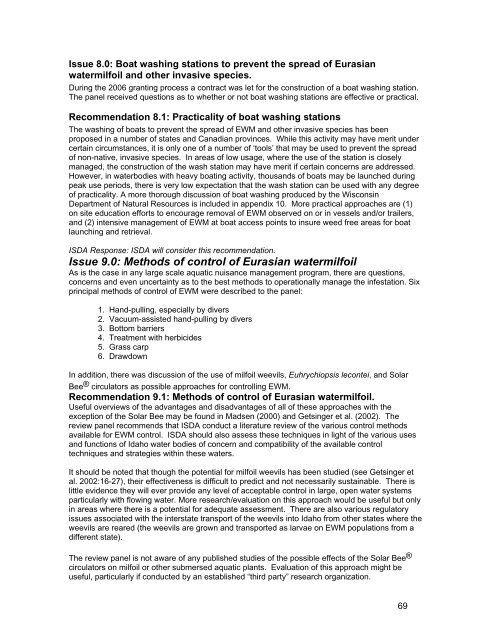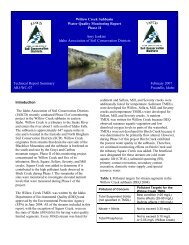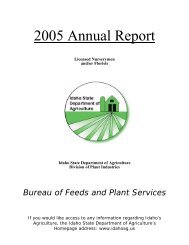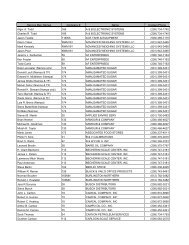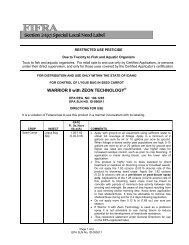2008 Statewide Strategic Plan for Eurasian Watermilfoil in Idaho
2008 Statewide Strategic Plan for Eurasian Watermilfoil in Idaho
2008 Statewide Strategic Plan for Eurasian Watermilfoil in Idaho
You also want an ePaper? Increase the reach of your titles
YUMPU automatically turns print PDFs into web optimized ePapers that Google loves.
Issue 8.0: Boat wash<strong>in</strong>g stations to prevent the spread of <strong>Eurasian</strong><br />
watermilfoil and other <strong>in</strong>vasive species.<br />
Dur<strong>in</strong>g the 2006 grant<strong>in</strong>g process a contract was let <strong>for</strong> the construction of a boat wash<strong>in</strong>g station.<br />
The panel received questions as to whether or not boat wash<strong>in</strong>g stations are effective or practical.<br />
Recommendation 8.1: Practicality of boat wash<strong>in</strong>g stations<br />
The wash<strong>in</strong>g of boats to prevent the spread of EWM and other <strong>in</strong>vasive species has been<br />
proposed <strong>in</strong> a number of states and Canadian prov<strong>in</strong>ces. While this activity may have merit under<br />
certa<strong>in</strong> circumstances, it is only one of a number of ‘tools’ that may be used to prevent the spread<br />
of non-native, <strong>in</strong>vasive species. In areas of low usage, where the use of the station is closely<br />
managed, the construction of the wash station may have merit if certa<strong>in</strong> concerns are addressed.<br />
However, <strong>in</strong> waterbodies with heavy boat<strong>in</strong>g activity, thousands of boats may be launched dur<strong>in</strong>g<br />
peak use periods, there is very low expectation that the wash station can be used with any degree<br />
of practicality. A more thorough discussion of boat wash<strong>in</strong>g produced by the Wiscons<strong>in</strong><br />
Department of Natural Resources is <strong>in</strong>cluded <strong>in</strong> appendix 10. More practical approaches are (1)<br />
on site education ef<strong>for</strong>ts to encourage removal of EWM observed on or <strong>in</strong> vessels and/or trailers,<br />
and (2) <strong>in</strong>tensive management of EWM at boat access po<strong>in</strong>ts to <strong>in</strong>sure weed free areas <strong>for</strong> boat<br />
launch<strong>in</strong>g and retrieval.<br />
ISDA Response: ISDA will consider this recommendation.<br />
Issue 9.0: Methods of control of <strong>Eurasian</strong> watermilfoil<br />
As is the case <strong>in</strong> any large scale aquatic nuisance management program, there are questions,<br />
concerns and even uncerta<strong>in</strong>ty as to the best methods to operationally manage the <strong>in</strong>festation. Six<br />
pr<strong>in</strong>cipal methods of control of EWM were described to the panel:<br />
1. Hand-pull<strong>in</strong>g, especially by divers<br />
2. Vacuum-assisted hand-pull<strong>in</strong>g by divers<br />
3. Bottom barriers<br />
4. Treatment with herbicides<br />
5. Grass carp<br />
6. Drawdown<br />
In addition, there was discussion of the use of milfoil weevils, Euhrychiopsis lecontei, and Solar<br />
Bee ® circulators as possible approaches <strong>for</strong> controll<strong>in</strong>g EWM.<br />
Recommendation 9.1: Methods of control of <strong>Eurasian</strong> watermilfoil.<br />
Useful overviews of the advantages and disadvantages of all of these approaches with the<br />
exception of the Solar Bee may be found <strong>in</strong> Madsen (2000) and Gets<strong>in</strong>ger et al. (2002). The<br />
review panel recommends that ISDA conduct a literature review of the various control methods<br />
available <strong>for</strong> EWM control. ISDA should also assess these techniques <strong>in</strong> light of the various uses<br />
and functions of <strong>Idaho</strong> water bodies of concern and compatibility of the available control<br />
techniques and strategies with<strong>in</strong> these waters.<br />
It should be noted that though the potential <strong>for</strong> milfoil weevils has been studied (see Gets<strong>in</strong>ger et<br />
al. 2002:16-27), their effectiveness is difficult to predict and not necessarily susta<strong>in</strong>able. There is<br />
little evidence they will ever provide any level of acceptable control <strong>in</strong> large, open water systems<br />
particularly with flow<strong>in</strong>g water. More research/evaluation on this approach would be useful but only<br />
<strong>in</strong> areas where there is a potential <strong>for</strong> adequate assessment. There are also various regulatory<br />
issues associated with the <strong>in</strong>terstate transport of the weevils <strong>in</strong>to <strong>Idaho</strong> from other states where the<br />
weevils are reared (the weevils are grown and transported as larvae on EWM populations from a<br />
different state).<br />
The review panel is not aware of any published studies of the possible effects of the Solar Bee ®<br />
circulators on milfoil or other submersed aquatic plants. Evaluation of this approach might be<br />
useful, particularly if conducted by an established “third party” research organization.<br />
69


